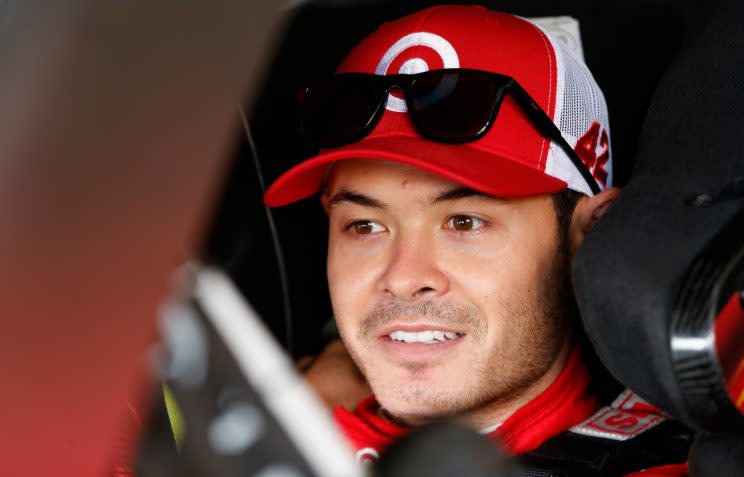Target didn't leave NASCAR because of Kyle Larson

Imagine for a second that you’re in charge of marketing at a large company. Ever since you’ve been at the company it’s had a large investment in a sponsorship that’s been fruitful for your brand exposure.
But as you take a closer look at the financials, you see that the dividends the sponsorship once paid may not be there anymore. The exposure the sponsorship gets has been steadily decreasing for years but your company’s costs aren’t going down accordingly. It’s not the opportunity it once was.
What do you do?
It’s not hard to envision a similar scenario playing out at Target in recent months as the company evaluated its investment in Chip Ganassi’s race teams. The company announced last season that it would leave IndyCar at the end of 2016 and said Friday that it wouldn’t be renewing its deal as Kyle Larson’s primary sponsor in the No. 42 car.
Larson is a sponsor’s dream. The 25-year-old is potentially NASCAR’s most exciting driver and has three wins in the last 36 races. He’s second in the points standings and, per Nielsen’s metrics, has generated more exposure for Target than any other company in NASCAR over the past season.
Yet he’s not the reason why Target ended its sponsorship. NASCAR and American auto racing is.
Per the Sports Business Journal, Target is turning its sports marketing efforts towards soccer, where the company already has a jersey sponsorship deal with MLS franchise Minnesota United. It’s an understandable decision. Soccer has the young fanbase NASCAR craves. That craving is a big reason why NASCAR took a cut-rate deal from Monster to sponsor the Cup Series for at least two seasons.
Soccer is also growing in popularity too. As NASCAR television ratings have declined and in-person attendance has slipped, MLS has added franchises and the English Premier League has become widely available on American television (thanks to NBC, one of NASCAR’s TV partners).
The loss of Target especially stings because the company was one of the few who still served as a majority primary sponsor for a Cup team. Target sponsored 29 of the 36 races in 2015 before beginning to pare back its sponsorship in 2016.
In the aftermath of Target’s announcement, NASCAR’s PR spin was in full effect touting a tired talking point that’s not nearly as positive as the sanctioning body wants you to believe. As the sport has hemorrhaged fans and teams have cut back cars, NASCAR has bragged about the number of large corporations involved in the sport.
A few fun facts re: sponsorship in 2017 (1 of 3): Nearly half of FORTUNE 100 companies invest in NASCAR – a YOY increase of 11%
— Jon Schwartz (@JonSchwartz1) July 28, 2017
Fun sponsorship facts (2 of 3): The no. of FORTUNE 500 companies investing in NASCAR has either grown or sustained year-over-year since 2012
— Jon Schwartz (@JonSchwartz1) July 28, 2017
Fun sponsorship facts (3 of 3): The no. of FORTUNE 500 companies investing in NASCAR has increased 29% since 2008
— Jon Schwartz (@JonSchwartz1) July 28, 2017
The numbers certainly sound impressive on the surface. But consider that Chip Ganassi Racing will likely find multiple sponsors to fill the void left by Target in 2018. If those, say, two companies are new to NASCAR, the sport can spin it as a plus one in the aftermath of the departure of one of its most identifiable sponsors.
As the costs of being competitive in NASCAR continue to rise, is a sport really healthier if a team has to find multiple companies to fill the void one left behind?
Besides, NASCAR didn’t have the litany of “official sponsors” 10 years ago that it does now. The sport had 41 “official partners” for everything ranging from official cookies and crackers to an official big rig and hauler in 2015. And that doesn’t include Lilly’s addition as the “official diabetes health partner of NASCAR” in March of 2017.
Yes, NASCAR even has an official diabetes health partner. Think about the multi-level absurdity of that for a second.
As racing has gotten more expensive while sponsor exposure has dwindled, teams have been forced to attract sponsorships in different ways. Business-to-business benefits have become more and more important, and a main reason why superteams owned by Rick Hendrick and Roger Penske have less trouble attracting sponsors.
“I think sponsorship contracts are going to keep to evolve and change,” Brad Keselowski said Saturday. “I think the traditional model is going to go extinct soon and could be argued that it’s here right now. The traditional model [of just] being a consumer brand sponsor that just wants to see a car out there with there name out it will go extinct in the next couple years. That’s not always a bad thing. There’s other models that work and have proven to be successful.
“And the teams, although the owners may not agree with it, are still relatively healthy. So, time will tell what the true model is 10 years from now. I don’t think anybody really knows. I don’t we have it as bad as we say we do.”
But Keselowski drives for Penske. With a prolific and multi-pronged automotive company at his disposal, Penske can ensure Pennzoil is used at his car dealerships as long as its on Joey Logano’s car while Hendrick can strike a deal with NAPA for its parts and Axalta for its automotive coating products.
Richard Childress, meanwhile, can’t offer the same benefits to companies as he looks to replace Menards if he wants to run a third car in 2018.
As a retailer, Target’s business-to-business opportunities with a NASCAR team are limited too. With business-to-business integration becoming more imperative for teams to be able to land sponsorship deals, the strongest NASCAR teams have even more of an advantage than their performance on the track gives them. And companies who don’t have a business-to-business angle to utilize may balk at the costs of sponsoring a team.
The new companies that are joining NASCAR may not always be paying very much either. When Jeffrey Earnhardt’s half-season sponsorship from Hulu for his backmarker No. 33 car was announced, the sponsorship was quickly lauded by many excited to see a technological company jump into the sport.
In the weeks after the deal was announced, Sports Business Journal noted the price of the sponsorship was about what it would cost a company to sponsor Dale Earnhardt Jr. for two races.
The precise dollar figure of Hulu’s deal could not be confirmed, but sources familiar with it said the amount was in the low to mid-five-figure range per race. That would pencil out to a fee that’s likely less than $1 million despite being for more than half the season, a fraction of what the sport’s top teams would typically ask for that length.
It’s hard to justify that cost discrepancy as being a positive for the sport, and yet another reason why it’s easy to understand why a company would be reluctant to shell out big bucks for a top-level team. If it wanted, it could just cut a smaller check and become yet another official sponsor of NASCAR.
Larson isn’t the only driver facing a sponsor shortage heading into 2018. Kasey Kahne’s future at Hendrick is tenuous, thanks at least in part to Great Clips and Farmers Insurance leaving his car at the end of this season and opening up 24 races in need of sponsorship. Clint Bowyer doesn’t have a full-time sponsor at Stewart-Haas Racing and Danica Patrick could leave the team at the end of the season because SHR hasn’t found a replacement for Nature’s Bakery.
Matt Kenseth, the 2003 series champion, doesn’t have a ride lined up for next season because he doesn’t have a sponsor. Without sponsorship, it’s hard to see RCR running the car Menard currently drives before he heads to Wood Brothers Racing in 2018.
And Furniture Row Racing could contract back to one car if it doesn’t find a sponsor and driver combination to replace Erik Jones, who is taking over for Kenseth at Joe Gibbs Racing.
Meanwhile, Bubba Wallace — the only black driver in NASCAR — is currently without a ride at all in 2017 after filling in for Aric Almirola. Before his substitute stint in the Cup Series for Almirola’s Smithfield-sponsored ride, Wallace’s Roush Fenway Racing Xfinity team was shut down due to, you guessed it, a lack of sponsorship.
All of those moving and departing pieces are a huge sign the NASCAR team sponsorship model is no longer sustainable, even if NASCAR tries to tout increased corporate involvement. The companies that pay hundreds of thousands of dollars to get Cup Series teams to the track every weekend are far more important to the health of the sport than the Sherwin-Williams deal to be the official paint of NASCAR.
The trick for NASCAR and its teams is to figure out a way to make it feasible for companies to invest in the sport. But it’s clearly not simple. If it was, Target would probably be signed to a multi-year extension in the hopes of being Larson’s sponsor if and when he wins his first Cup title and Kenseth would have a ride lined up for 2018.
The financial health of many facets of the sport is about to be tested. While NASCAR itself may be doing just fine, a contracted Cup Series field chasing after many of the same sponsorship opportunities isn’t a good vital sign.
– – – – – – –
Nick Bromberg is the editor of Dr. Saturday and From the Marbles on Yahoo Sports. Have a tip? Email him at nickbromberg@yahoo.com or follow him on Twitter!




